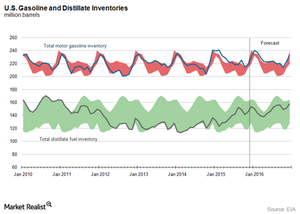Will the Gasoline and Distillate Inventory Pressure Crude Oil Prices?
The API (American Petroleum Institute) published its weekly crude oil, gasoline, and distillate inventory report on January 12, 2016.
Jan. 13 2016, Published 10:02 a.m. ET

API’s gasoline and distillate inventory report
The API (American Petroleum Institute) published its weekly crude oil, gasoline, and distillate inventory report on January 12, 2016. The API reported that the US gasoline inventory rose by 7 MMbbls (million barrels) for the week ending January 8, 2016. Likewise, the distillate inventory rose by 3.7 MMbbls for the same period. The API’s refined products inventory report could continue to put pressure on the oil market.
EIA’s gasoline and distillate inventory report
The EIA (U.S. Energy Information Administration) reported that the US gasoline inventory rose by 10.6 MMbbls to 232 MMbbls for the week ending January 1, 2016. Likewise, the US distillate inventory rose by 6.3 MMbbls to 159.4 MMbbls for the same period. Market surveys from Reuters suggest that US gasoline could rise by 2.7 MMbbls for the week ending January 8, 2016. During the same period, the US distillate inventory could rise by 2 MMbbls.
Impact
The consensus of the rising refined products inventory will continue to add fuel to the fire in the crude oil market. It suggests weak demand for refined products. As a result, the crude oil demand will fall. The refined products inventory might have increased due to weak refinery demand. A rise in the refined products’ inventory is bearish for oil refineries like Western Refining (WNR), Alon (ALDW), and Northern Tier Energy (NTI). However, rising refinery demand benefits US oil producers like Whiting Petroleum (WLL) and Continental Resources (CLR).
The volatility in the oil and gas market impacts ETFs like the ProShares UltraShort Bloomberg Crude Oil ETF (SCO), the Vanguard Energy ETF (VDE), and the First Trust Energy AlphaDEX Fund (FXN).
In the next part, we’ll discuss how OPEC (Organization of the Petroleum Exporting Countries) is influencing the global oil market.
